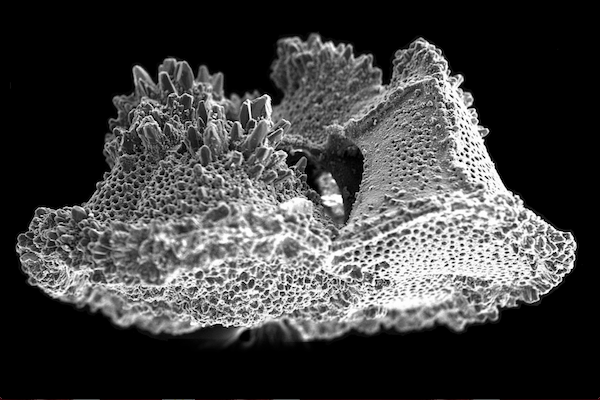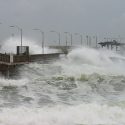New techniques sharpen climate record found in fossil shells

The microscopic shells of marine organisms known as planktonic foraminifera hold a detailed chemical record of past climate and ocean conditions. New techniques applied by a UW–Madison group help refine estimates of climate from 56 million years ago when the Earth experienced a remarkable climate episode that mirrors what climatologists believe is happening to Earth today.
Image courtesy of Reinhard Kozdon
Locked inside the fossil shells of a marine plankton are the secrets of past climate.
The single-celled, microscopic organisms known as planktonic foraminifera inhabit the surface waters of the world’s oceans, where their shells soak up information about their environment — notably, sea surface temperature, salinity and chemistry. At death, their calcium carbonate shells rain to the ocean floor where they form layers of sediment, providing a continuous fossil record dating back 150 million years.
To scientists, the plankton have become a critical archive of past climate as the chemistry of their shells, in particular their isotopic composition, provides a record of climate when the organisms were alive.

Reinhard Kozdon
Now, however, a team of researchers from UW–Madison, writing this week (Oct. 12, 2013) in the journal Paleoceanography, shows that past climates can be more faithfully recapitulated by harnessing technologies that permit analysis of the shells at scales millions of times smaller than conventional methods. The work is important because it promises to significantly sharpen pictures of past climate and, consequently, the models now used to forecast future climate.
“We can improve our understanding of past climate by making more accurate measurements of past ocean temperatures and conditions,” says Reinhard Kozdon, a UW–Madison geochemist and the lead author of the new Paleoceanography report.
Proxies of past climate like foraminiferal shells help validate the accuracy of the models used to predict future climate as the models can be run backward in time and matched to the physical evidence of climate from thousands or millions of years ago.
The Wisconsin team, which also included researchers Clay Kelly and John Valley, chose a remarkable climate episode in Earth’s history, one critical for climate modelers as it mirrors what climatologists believe is happening with Earth’s climate today. Known to scientists as the “Paleocene-Eocene thermal maximum” or PETM, the climate episode occurred 56 million years ago and was characterized by rapid global warming, major ecological disruption — including mass extinctions of many marine and terrestrial organisms — and a profound shift in the planet’s carbon cycle.

Clay Kelly
Using a marine core sediment sample from an underwater seamount in the equatorial Pacific Ocean, the Wisconsin team focused on a 56-million-year-old horizon in the core sample where large crystallites composed from calcium carbonate formed in the sediment matrix as well as on the microfossil shells. The crystallites are believed to come from an inorganic processes known as diagenesis.
“The signal required to measure past climate is what is formed biologically by the organism in the surface ocean,” Kozdon explains, noting that the inorganic crystallites, although atypically large in these samples, are ubiquitous on fossil shells and usually form after the organisms perished and the shell sank to the seafloor. “Because of that, part of the shell could be chemically altered, which could affect information about past climate reflected in the shell.”
According to Kozdon and Kelly, conventional methods to analyze foraminiferal shell oxygen isotope ratios, which reflect sea surface temperature and ocean salinity of the past, required analysis of up to 15 of the microscopic shells, including the unwanted inorganic material. Thus, data obtained by conventional analytical methods are potentially compromised by postmortem contamination from the inorganic crystals that form in sea floor sediments. The result, according to the Wisconsin team, could be an underestimate of past sea surface temperatures.
The new findings, in fact, help further resolve what scientists call the “cool tropics paradox,” where modeled estimates of past climate during periods when the Earth was known to be warm conflicted with estimates of cooler tropical sea surface temperatures, as suggested by conventional analyses of planktonic foraminifera shells.

John Valley
The techniques used by Kozdon and his colleagues surmount the contamination problem as they can sample small spots on individual shells, thereby precisely targeting the material that records past environmental conditions and excluding the unwanted contaminating crystals. These highly selective measurements were not possible using the conventional methods of the past three or four decades to sample foraminiferal shell isotope ratios. In addition, the contaminating calcite blades and crystallites were sampled to obtain information that can be used to apply corrections for data retrieved by conventional methods.
Kozdon, Kelly and their collaborators used two specialized instruments — a secondary ion mass spectrometer and an electron probe microanalyzer — to sample 10-micrometer diameter spots on the shells of individual plankton.
The ability to sample fossil material at such small scales, according to Kozdon, will significantly enhance the fidelity of past climate signals and make the models we depend on to assess future climate change even more accurate.
Tags: climate change, research



